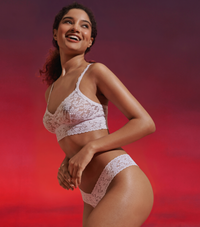Our History
In 1977, designer Gale Epstein created a handmade lingerie set for her friend, Lida Orzeck, crafted out of embroidered handkerchiefs. The original designs wowed retailers and industry experts and were the inspiration for the company name, Hanky Panky.
With the inception of the hanky set in the seventies to the thongs of today, Hanky Panky continues to influence trends in lingerie and sleepwear. Blending traditional with modern glam looks, Hanky Panky proudly provides brilliant solutions for fashion fit issues by remaining dedicated to innovative design, comfort, quality and US production.
The WORLD’S MOST COMFORTABLE THONG®
Hanky Panky set a new standard for thongs when the 4811 was introduced in 1986. In a front page Wall Street Journal article about them in 2004, Hanky Panky’s thongs were described as “lace butter”. Leading fashion magazines and celebrities regularly extol their revolutionary comfort and beauty
MATERIALS
Hanky Panky garments are made from the best materials. Components are chosen for their specific stretch qualities, softness and fit. Also, 100% of the fabrics and trims used to make our Signature Lace styles are knitted in the USA. Even the Supima® cotton fibers used to make crotch linings are grown in the USA. Our Signature Lace is an exclusive pattern available only to Hanky Panky.
CRAFTSMANSHIP
Our garments are constructed utilizing the best methods available. For example, each thong uses over 30 yards of thread. More thread means more stitches per inch, and more stitches means a more durable, high quality product.
COPYCATS
We’ve been making our signature lace styles for a long time now, and there are many knockoffs available at every price point. Ours is still far and away the superior product. Many of the copycats may look the same superficially, but they do not have our exclusive laces (protected by copyright), and they do not have our signature fit, feel and long life. Also, many of these copycats are manufactured in countries where there is no guarantee of humane working conditions, so these “bargains” may come at the cost of the health and safety of the people who make them.











